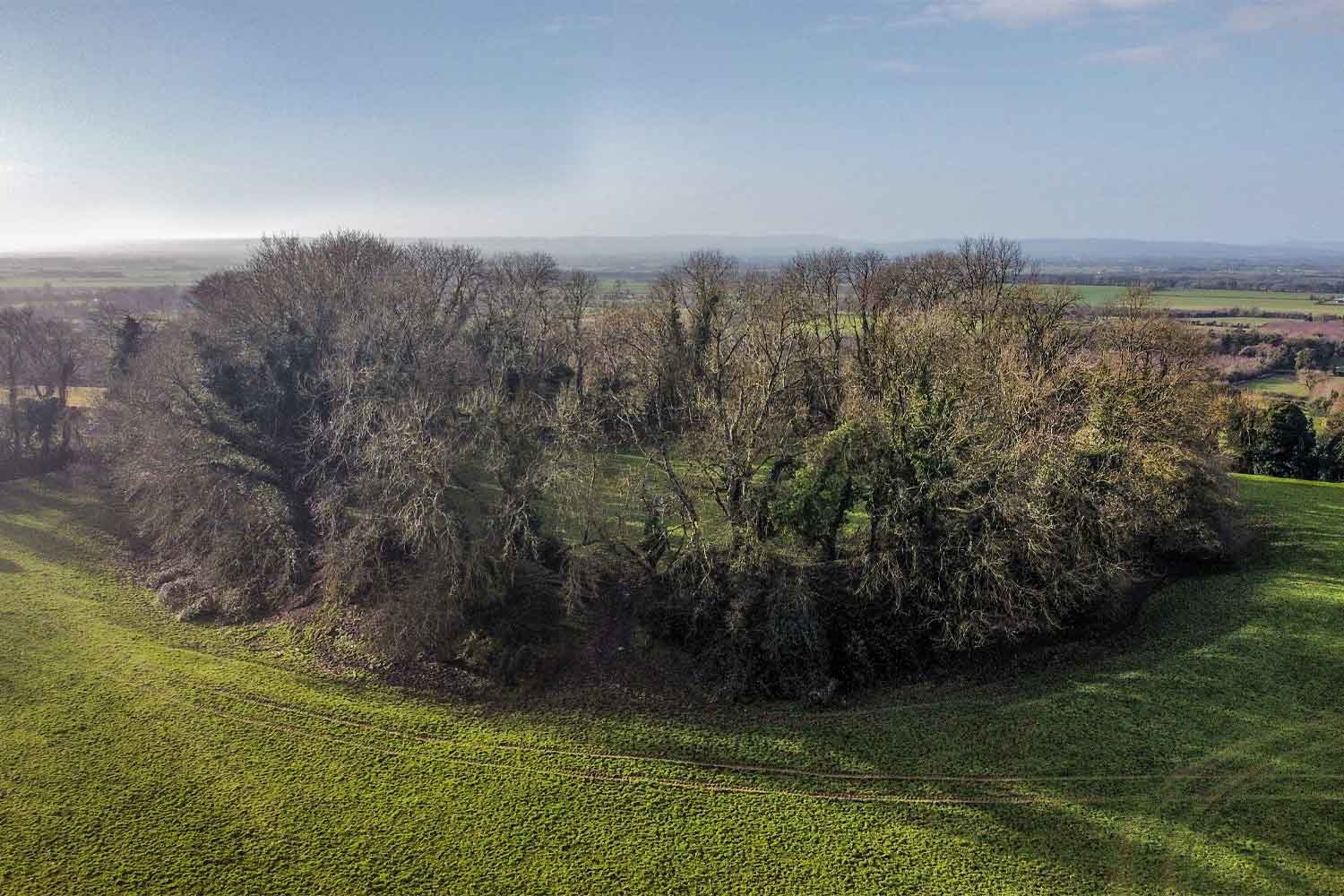Mullaghmast Ringfort

Location: Mullamast, Co. Kildare
Classification: Ringfort - Rath
SMR Code: KD036-008----
Rating:
Mullaghmast is a very large ring fort, located about 3km west of Ballitore in County Kildare. A circular interior (Diameter 56m) is surrounded by a 3m high bank and deep fosse with an entrance to the east. A line of 6 Barrows (Bronze & iron Age funerary monuments) run in a line, from the Rath at the summit, down the south side of the hill. A large standing stone is located about 400m south of the Rath. Although Mullaghmast is classified as a ringfort: (A residence and/or farmstead, built sometime between 500 to 1000 AD): Similar to the “ring forts” at other Royal Sites, such as Tara or Uisneach, it may have been built centuries earlier as a ceremonial enclosure or henge monument that was modified in the early Medieval period for use as an inauguration site and/or royal residence.
Although presumably a site of some significance going back into prehistory, Mullaghmast was the ceremonial seat of the Kings of Leinster in the centuries leading up to the Norman invasion of the 12th Century. On New Years Day 1577 forty Leinster chieftains were massacred in the fort by the English military after they had been invited to Mullaghmast to discuss a peace settlement. Daniel O' Connell addressed a meeting at the Rath for a repeal of the Act Of Union (1801) between the Irish and British Parliaments.
According to the Dindshenchas, Mullaghmast (from the Irish ‘Mullach Maistiu’ meaning ‘High Place of Maistiu’) was named after Maistiu (“of the lovely radiance”), who was the wife of Dáire Derg, the king of Nás (Naas). It is said that the evil fairy Gris killed Maistiu by sorcery; depriving her of “modesty and of might“. Dáire Derg, avenged his wife’s death by casting a magical spear at Gris which killed her and turned her into a river (the nearby, River Greese).
Description
Mullaghmast is a very large ring fort, located about 3km west of Ballitore in County Kildare. A circular interior (Diameter 56m) is surrounded by a 3m high bank and deep fosse with an entrance to the east. A line of 6 Barrows (Bronze & iron Age funerary monuments) run in a line, from the Rath at the summit, down the south side of the hill. A large standing stone is located about 400m south of the Rath. Although Mullaghmast is classified as a ringfort: (A residence and/or farmstead, built sometime between 500 to 1000 AD): Similar to the “ring forts” at other Royal Sites, such as Tara or Uisneach, it may have been built centuries earlier as a ceremonial enclosure or henge monument that was modified in the early Medieval period for use as an inauguration site and/or royal residence.
History
Although presumably a site of some significance going back into prehistory, Mullaghmast was the ceremonial seat of the Kings of Leinster in the centuries leading up to the Norman invasion of the 12th Century. On New Years Day 1577 forty Leinster chieftains were massacred in the fort by the English military after they had been invited to Mullaghmast to discuss a peace settlement. Daniel O' Connell addressed a meeting at the Rath for a repeal of the Act Of Union (1801) between the Irish and British Parliaments.
Folklore
According to the Dindshenchas, Mullaghmast (from the Irish ‘Mullach Maistiu’ meaning ‘High Place of Maistiu’) was named after Maistiu (“of the lovely radiance”), who was the wife of Dáire Derg, the king of Nás (Naas). It is said that the evil fairy Gris killed Maistiu by sorcery; depriving her of “modesty and of might“. Dáire Derg, avenged his wife’s death by casting a magical spear at Gris which killed her and turned her into a river (the nearby, River Greese).
Accessibility Rating: Moderate
The ring fort is located in a field about 100m west of the road (L8028). It is on private land so permission should be sought, but limited access does seem to be granted.
There are no facilities at this monument.
Accessibility
Accessibility Class: Moderate
The ring fort is located in a field about 100m west of the road (L8028). It is on private land so permission should be sought, but limited access does seem to be granted.
Facilities
There are no facilities at this monument.
Map
Users should note that the Monumental Ireland application and website are information guides only and do not act as an invitation to enter any of the properties or sites listed. No responsibility is accepted by the creators of the Monumental Ireland application for any loss, injury or inconveniences sustained as a result of using it.






